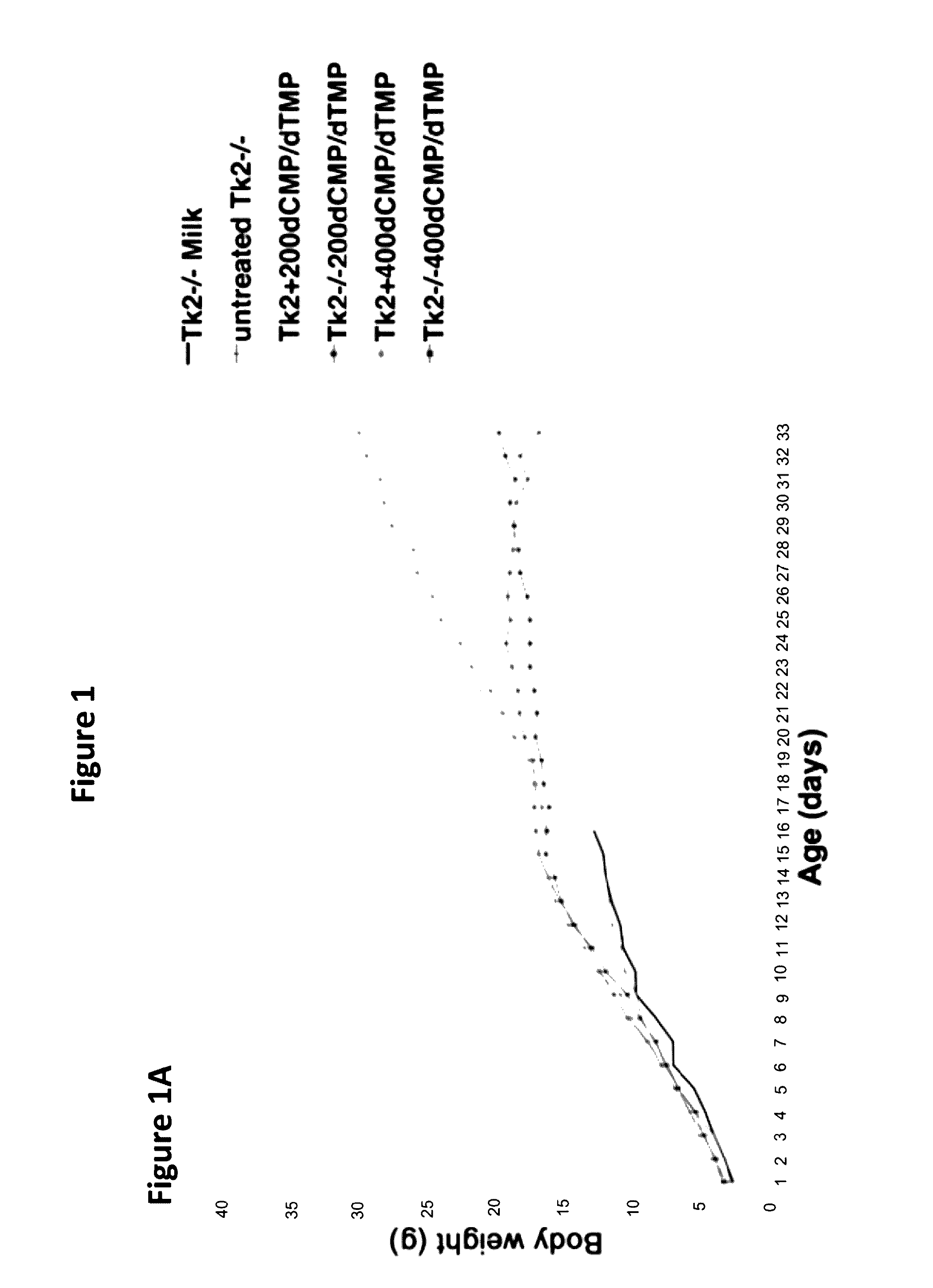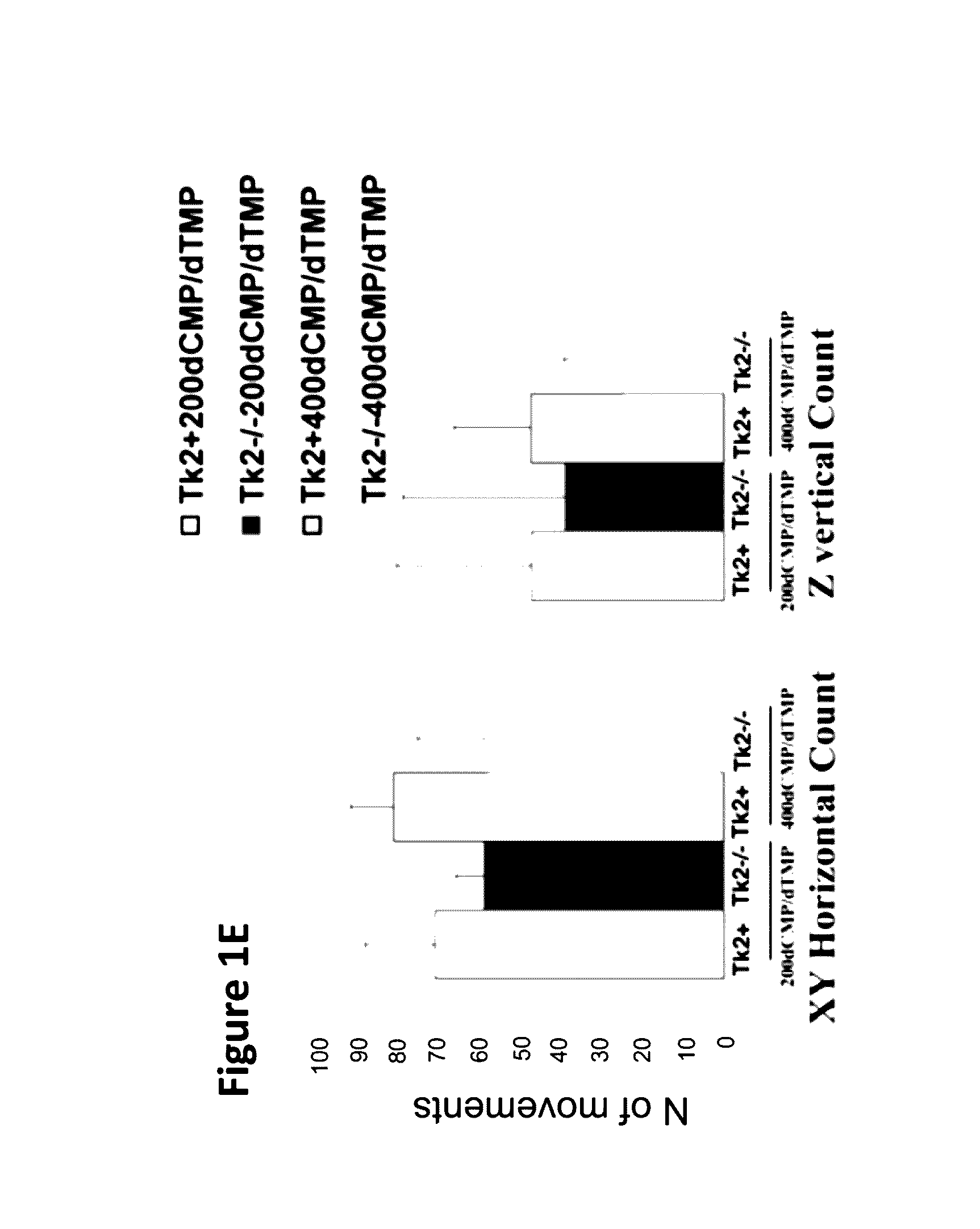Deoxyribonucleoside monophospate bypass therapy for mitochondrial DNA depletion syndrome
a technology of mitochondrial dna depletion syndrome and deoxyribonucleoside monophospate, which is applied in the field of human genetic disease pharmaceutical therapy, can solve the problems of mitochondrial diseases, mitochondrial diseases, and most mitochondrial diseases affecting multiple body organs
- Summary
- Abstract
- Description
- Claims
- Application Information
AI Technical Summary
Benefits of technology
Problems solved by technology
Method used
Image
Examples
example 1
Materials and Methods for Examples 2-6
Mouse Model of TK2 Deficiency
[0080]A homozygous Tk2 H126N knock-in mutant (Tk2− / −) mouse that manifests a phenotype strikingly similar to the human infantile encephalomyopathy has been previously reported (Akman, et al. 2008). Between postnatal day 10 and 13, Tk2− / − mice rapidly develop fatal encephalomyopathy characterized by decreased ambulation, unstable gait, coarse tremor, growth retardation, and rapid progression to early death at age 14 to 16 days. Molecular and biochemical analyses of the mouse model demonstrated that the pathogenesis of the disease is due to loss of enzyme activity and ensuing dNTP pool imbalances with decreased dTTP levels in brain and both dTTP and dCTP levels in liver, which, in turn, produces mtDNA depletion and defects of respiratory chain enzymes containing mtDNA-encoded subunits, most prominently in the brain and spinal cord (Dorado, et al. 2011).
[0081]All experiments were performed according to a protocol approv...
example 2
dCMP / dTMP Delays Disease Onset, Prevents Neuromuscular Manifestations, and Prolongs Lifespan of Tk2-Deficient Mice
[0096]Oral treatment with dCMP+dTMP 200 mg / kg / day each in milk (Tk2− / −200dCMP / dTMP) beginning at postnatal day 4 delayed disease onset to 20-25 days when the mutant mice developed a mild tremor and stopped gaining weight (data not shown). In the fourth week, they manifested weakness and reduced movements. In contrast, Tk2− / − mice treated from day 4 with dCMP+dTMP 400 mg / kg / day each in milk (Tk2− / −400dCMP / dTMP) appeared normal until day 21, when weight gain decelerated and mild head tremor developed (FIG. 1A).
[0097]Untreated Tk2− / − mice had a mean lifespan of 13.2±2.5 days (mean±SD), whereas Tk2− / −200dCMP / dTMP survived to 34.6±3.2 days (P=0.0028; n=7; Gehan-Breslow-Wilcoxon test) while Tk2− / −400dMP / dTMP lived to 44.3±9.1 days (P=0.0071; n=7; Gehan-Breslow-Wilcoxon test) (FIG. 1B). The cause of death was not evident in postmortem histological studies of major organs in 29-...
example 3
Histological and Histochemical CNS Studies Confirmed dCMP / dTMP Efficacy
[0100]Efficacy of treatment in central nervous system (CNS) was demonstrated in histological studies that showed dramatic reductions in the numbers of vacuoles in neurons of the spinal cord and cerebellar and brain stem nuclei of 13-day-old Tk2− / −200dCMP / dTMP mice relative to untreated 13-day-old Tk2− / − mice (FIGS. 3A and 3B). Furthermore, cytochrome c oxidase (COX, complex IV) histochemistry of cerebellum revealed reduced overall COX activity in 13-day-old untreated Tk2− / − mice (FIG. 4A) with normal activities in 13- and 29-day-old Tk2− / −200dCMP / dTMP (FIGS. 4C and 4E) relative to Tk2+ animals (FIGS. 4B, 4D, and 4F). No cell-specific immunohistochemical differences in COX protein were detected (FIGS. 4G and 4H) while severe reduction in complex I was identified by immunostaining of cerebellum of 29-day-old Tk2− / −200dCMP / dTMP (FIGS. 4I and 4J).
PUM
| Property | Measurement | Unit |
|---|---|---|
| Frequency | aaaaa | aaaaa |
| Frequency | aaaaa | aaaaa |
| Frequency | aaaaa | aaaaa |
Abstract
Description
Claims
Application Information
 Login to View More
Login to View More - R&D
- Intellectual Property
- Life Sciences
- Materials
- Tech Scout
- Unparalleled Data Quality
- Higher Quality Content
- 60% Fewer Hallucinations
Browse by: Latest US Patents, China's latest patents, Technical Efficacy Thesaurus, Application Domain, Technology Topic, Popular Technical Reports.
© 2025 PatSnap. All rights reserved.Legal|Privacy policy|Modern Slavery Act Transparency Statement|Sitemap|About US| Contact US: help@patsnap.com



